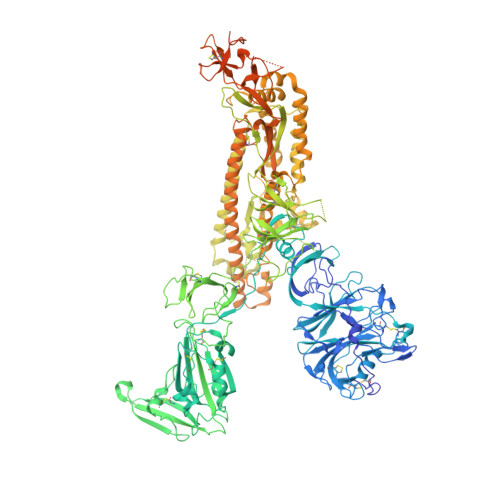Rapid simulation of glycoprotein structures by grafting and steric exclusion of glycan conformer libraries.
Tsai, Y.X., Chang, N.E., Reuter, K., Chang, H.T., Yang, T.J., von Bulow, S., Sehrawat, V., Zerrouki, N., Tuffery, M., Gecht, M., Grothaus, I.L., Colombi Ciacchi, L., Wang, Y.S., Hsu, M.F., Khoo, K.H., Hummer, G., Hsu, S.D., Hanus, C., Sikora, M.(2024) Cell 187: 1296-1311.e26
- PubMed: 38428397
- DOI: https://doi.org/10.1016/j.cell.2024.01.034
- Primary Citation of Related Structures:
7YMT, 7YMV, 7YMW, 7YMX, 7YMY, 7YMZ, 7YN0 - PubMed Abstract:
Most membrane proteins are modified by covalent addition of complex sugars through N- and O-glycosylation. Unlike proteins, glycans do not typically adopt specific secondary structures and remain very mobile, shielding potentially large fractions of protein surface. High glycan conformational freedom hinders complete structural elucidation of glycoproteins. Computer simulations may be used to model glycosylated proteins but require hundreds of thousands of computing hours on supercomputers, thus limiting routine use. Here, we describe GlycoSHIELD, a reductionist method that can be implemented on personal computers to graft realistic ensembles of glycan conformers onto static protein structures in minutes. Using molecular dynamics simulation, small-angle X-ray scattering, cryoelectron microscopy, and mass spectrometry, we show that this open-access toolkit provides enhanced models of glycoprotein structures. Focusing on N-cadherin, human coronavirus spike proteins, and gamma-aminobutyric acid receptors, we show that GlycoSHIELD can shed light on the impact of glycans on the conformation and activity of complex glycoproteins.
Organizational Affiliation:
Institute of Biological Chemistry, Academia Sinica, Taipei 11529, Taiwan; Institute of Biochemical Sciences, National Taiwan University, Taipei 10617, Taiwan.


















